Birthingtent |
|
||
| Dré Wapenaar 2003 Photo © Robbert R. Roos Collection: Museum Boijmans van Beuningen Rotterdam, The Netherlands Production steel frame: Verbakel Schiedam Production / Manufacturing: Studio Dré Wapenaar Wooden Tub: Billy Leliveld Pregnant couple: Anneriek Goudappel and Jan de Leeuw, Nico on the way. | BIRTHINGTENT BAARTENT Both Birthingtent and Bivouac for the Dead can be seen as "counterpoints" Dré Wapenaar says of his work: "In my latest tents the theme of the loner versus the group, and or the other, comes into a phase in which the interaction, and the expectations that come with it, will be directed even more. This was already at stake in the works where I used a, so called, necessity which you could hardly deny. Here, things are dealing more with emotional issues, with intimacy and distance, with attraction and repulsion, with respect for respect and disrespect. " Onlangs maakte Wapenaar ook een Baartent (2003) - het zou de pendant van de Dodenbivak kunnen zijn. De Baartent is een schuilplaats voor het ritueel van de bevalling. Het zachtoranje, bolvormige bouwsel herbergt een eenvoudig baartrapje met waterbassin dat een vloeiende geboorte garandeert. De tent is aan de bovenzijde open, zodat de baby onder de sterrenhemel ter wereld kan komen.” Wilma Sütö ( curator Stadscollectie Museum Boijmans van Beuningen ) schrijft erover in de catalogus van de tentoonstelling SHINE “Zoals Rince de Jong de kunst infiltreert met een onopgesmukt verslag van de oude levensdag, zo probeert andersom Dré Wapenaar in het leven door te dringen met beelden die de rituelen van leven en dood versterken. Wapenaar (1961, Berkel en Rodenrijs) werkt op het kruispunt van architectuur, design en beeldende kunst, als een regisseur van ontmoetingen. Hij bouwt sociale sculpturen: een tentenkamp in de vorm van een paddenstoelenkring; een krantenkiosk met het silhouet van een communicatiesatelliet. Zijn Dodenbivak (2002) is een rechthoekige tent van semi-transparant blauw doek. De contouren zijn open, in het midden van de lichte constructie hangt de baar * los van de grond, als in een opwaartse beweging. Pendant van dit dodenbivak is de Baartent (2003) in de vorm van een bol. Hierin is een bad ondergebracht waarin de moeder haar weeën kan opvangen, terwijl voor de baby de overgang van baarmoeder naar buitenwereld vloeiend verloopt. Het dak van de Baartent kan open, zodat het kind in een veilige omhulling, toch onder de sterrenhemel op aarde kan komen.” The Birthing Tent is, at the title indicates, a large bol structure designed for giving birth and for the celebration of this intimate moment. A large opening in the ceiling provides a view to the stars and the tent is equipped with benches for husbands, family, friends and nurses to participate in the experience. And again in the catalogue for “ the INTERVENTIONIST”, MassMoca N.A., June 2004 – May 2005 Nato writes: “Looking through the lens of displacement and trans-nationality (or non-nationality), the abundance of tents in the exhibition comes into focus. The tent is mobile architecture that folds up and is easy for one person to carry. The tent provides a home for those trespassing or camping out in public space. It facilitates autonomy, and like a bandage, points to the need for autonomy for displaced populations. Perhaps no one, except Buckminster Fuller, has explored the possibilities of tents more than Dutch artist/designer Dré Wapenaar. Wapenaar has produced tents for reading newspapers, playing pianos, hanging off trees, and, in this exhibition, a tent for giving birth and for memorializing the dead. Tents have surely come a long way. “ |

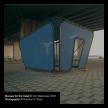
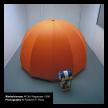

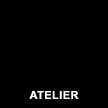







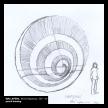
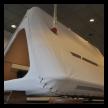
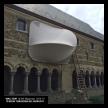
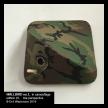
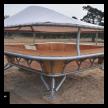


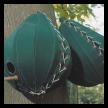


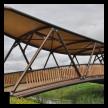
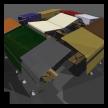
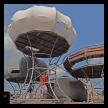
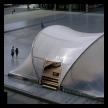
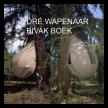
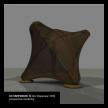
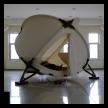
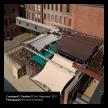
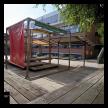
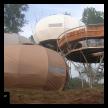
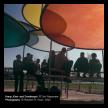

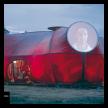
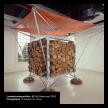
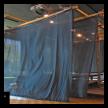
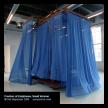

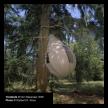
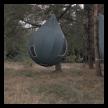
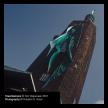
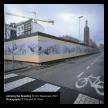
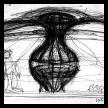
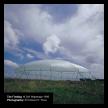
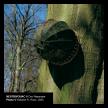

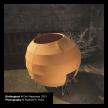


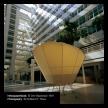
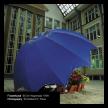
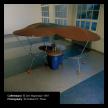
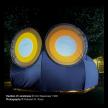
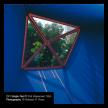

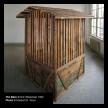
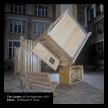
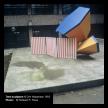

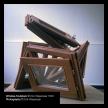

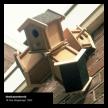
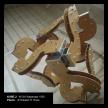
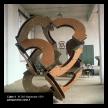

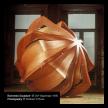

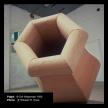
Webdesign:
Studio GloriusVandeVen